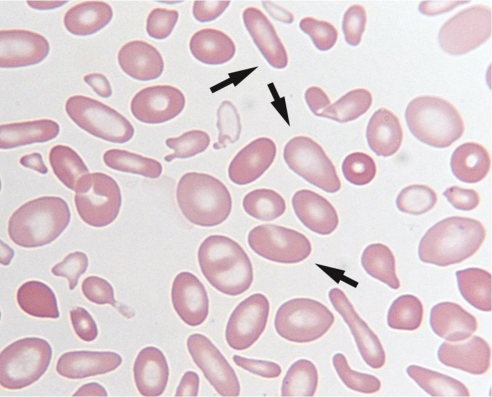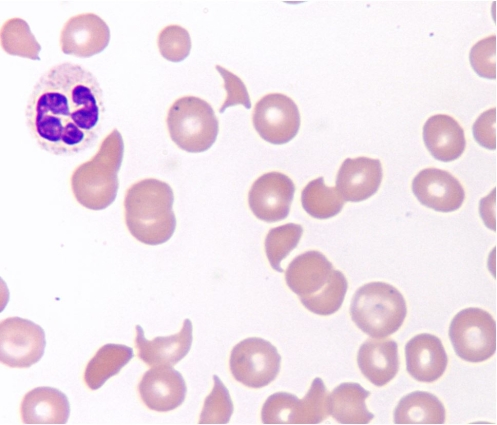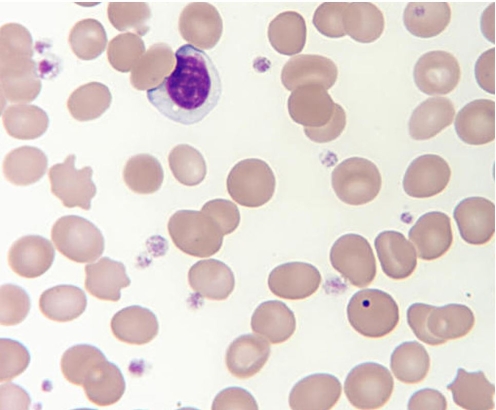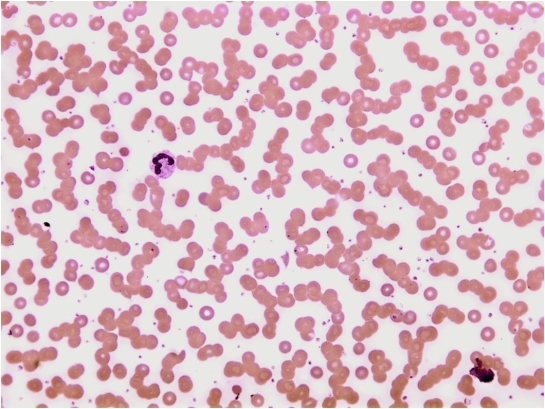Deck 10: The Complete Blood Count and Peripheral Blood Smear Evaluation
Question
Question
Question
Question
Question
Question
Question
Question
Question
Question
Question
Question
Question
Question
Question
Question
Question
Question
Question
Question
Question
Question
Question
Question
Question
Question
Question
Question
Question
Question
Question
Question
Question
Question
Question
Question
Question
Question
Question
Question

Unlock Deck
Sign up to unlock the cards in this deck!
Unlock Deck
Unlock Deck
1/40
Play
Full screen (f)
Deck 10: The Complete Blood Count and Peripheral Blood Smear Evaluation
1
Which RBC inclusion is characterized by diffusely staining RNA precipitate that can be seen when blood is stained with Wright's stain?
A) Heinz bodies
B) Pappenheimer bodies
C) Howell-Jolly bodies
D) Basophilic stippling
A) Heinz bodies
B) Pappenheimer bodies
C) Howell-Jolly bodies
D) Basophilic stippling
Basophilic stippling
2
Platelet estimates are usually performed on a blood smear using which microscopic magnification?
A) 10x
B) 100x
C) 400x
D) 1000x
A) 10x
B) 100x
C) 400x
D) 1000x
1000x
3
Which of the following represents the correct units for reporting an absolute reticulocyte count?
A) 15 × 109/L
B) 15 × 103/L
C) 15%
D) 15 × 1012/L
A) 15 × 109/L
B) 15 × 103/L
C) 15%
D) 15 × 1012/L
15 × 109/L
4
An instrument printout indicates an MCV of 63 fl and an MCHC of 26 g/dl. How will the red cells appear under the microscope?
A) Normocytic, normochromic
B) Macrocytic, normochromic
C) Microcytic, hypochromic
D) Normocytic, hypochromic
A) Normocytic, normochromic
B) Macrocytic, normochromic
C) Microcytic, hypochromic
D) Normocytic, hypochromic

Unlock Deck
Unlock for access to all 40 flashcards in this deck.
Unlock Deck
k this deck
5
Which poikilocyte is indicated by the arrows in the following image? 
A) Spherocytes
B) Macrocytes
C) Schistocytes
D) Elliptocytes

A) Spherocytes
B) Macrocytes
C) Schistocytes
D) Elliptocytes

Unlock Deck
Unlock for access to all 40 flashcards in this deck.
Unlock Deck
k this deck
6
How does the mean cell volume value classify cells?
A) Normochromic, hypochromic, and hyperchromic
B) Normocytic, microcytic, macrocytic
C) Poikilocytosis
D) Polychromasia
A) Normochromic, hypochromic, and hyperchromic
B) Normocytic, microcytic, macrocytic
C) Poikilocytosis
D) Polychromasia

Unlock Deck
Unlock for access to all 40 flashcards in this deck.
Unlock Deck
k this deck
7
The hemoglobin and hematocrit on a newborn are 18.9 g/dL and 60%. How would you interpret these data?
A) Lower than expected on a newborn
B) Higher than expected on a newborn
C) Expected results on a newborn
D) Erroneous results that should be rejected
A) Lower than expected on a newborn
B) Higher than expected on a newborn
C) Expected results on a newborn
D) Erroneous results that should be rejected

Unlock Deck
Unlock for access to all 40 flashcards in this deck.
Unlock Deck
k this deck
8
Which of the following assays is not part of a typical complete blood count?
A) RBC count
B) Mean cell hemoglobin concentration
C) Plasma ferritin
D) Platelet count
A) RBC count
B) Mean cell hemoglobin concentration
C) Plasma ferritin
D) Platelet count

Unlock Deck
Unlock for access to all 40 flashcards in this deck.
Unlock Deck
k this deck
9
Which of the following laboratory values would best correlate with moderate polychromasia on a peripheral blood smear?
A) A low RBC count
B) A retic count of 8%
C) Schistocytes on the PB smear
D) A low PLT count
A) A low RBC count
B) A retic count of 8%
C) Schistocytes on the PB smear
D) A low PLT count

Unlock Deck
Unlock for access to all 40 flashcards in this deck.
Unlock Deck
k this deck
10
How would you differentiate between an acanthocyte and an echinocyte?
A) The variety in length and distribution of the spikes
B) The number of spikes
C) The presence or absence of a fish-mouth central pallor
D) The size of the cell
A) The variety in length and distribution of the spikes
B) The number of spikes
C) The presence or absence of a fish-mouth central pallor
D) The size of the cell

Unlock Deck
Unlock for access to all 40 flashcards in this deck.
Unlock Deck
k this deck
11
While performing a 100-cell manual WBC differential, the laboratory professional observes Dohle bodies, toxic granulation and vacuoles in many neutrophils. This would suggest:
A) Megaloblastic anemia
B) Acute leukemia
C) Bacterial infection
D) Chronic leukemia
A) Megaloblastic anemia
B) Acute leukemia
C) Bacterial infection
D) Chronic leukemia

Unlock Deck
Unlock for access to all 40 flashcards in this deck.
Unlock Deck
k this deck
12
Remnants of DNA inside an RBC produce which type of inclusion?
A) Howell-Jolly bodies
B) Basophilic stippling
C) Cabot rings
D) Pappenheimer bodies
A) Howell-Jolly bodies
B) Basophilic stippling
C) Cabot rings
D) Pappenheimer bodies

Unlock Deck
Unlock for access to all 40 flashcards in this deck.
Unlock Deck
k this deck
13
A peripheral blood smear exhibits heterogeneity in RBC size distribution throughout the smear. Which of the RBC indices would be most indicative of this?
A) MCHC
B) MCV
C) RDW
D) MCH
A) MCHC
B) MCV
C) RDW
D) MCH

Unlock Deck
Unlock for access to all 40 flashcards in this deck.
Unlock Deck
k this deck
14
Which of the following is the proper order for reporting a CBC with one or more critical values:
A) Repeat for confirmation, report in LIS with documentation
B) Fax to RN, repeat for confirmation, report in LIS
C) Report in LIS, repeat for confirmation, phone MD
D) Repeat for confirmation, phone MD, report in LIS with documentation
A) Repeat for confirmation, report in LIS with documentation
B) Fax to RN, repeat for confirmation, report in LIS
C) Report in LIS, repeat for confirmation, phone MD
D) Repeat for confirmation, phone MD, report in LIS with documentation

Unlock Deck
Unlock for access to all 40 flashcards in this deck.
Unlock Deck
k this deck
15
Identify the poikilocytes indicated by the arrows in the following image. 
A) Acanthocytes
B) Drepanocytes
C) Schizocytes
D) Spherocytes

A) Acanthocytes
B) Drepanocytes
C) Schizocytes
D) Spherocytes

Unlock Deck
Unlock for access to all 40 flashcards in this deck.
Unlock Deck
k this deck
16
Which RBC parameter describes the average volume of the RBCs in a blood sample?
A) MCV
B) RDW
C) Reticulocyte count
D) MCHC
A) MCV
B) RDW
C) Reticulocyte count
D) MCHC

Unlock Deck
Unlock for access to all 40 flashcards in this deck.
Unlock Deck
k this deck
17
What RBC inclusions cannot be seen with Romanowsky stain but can be visualized with supravital stain?
A) Howell-Jolly bodies
B) Pappenheimer bodies
C) Cabot rings
D) Heinz bodies
A) Howell-Jolly bodies
B) Pappenheimer bodies
C) Cabot rings
D) Heinz bodies

Unlock Deck
Unlock for access to all 40 flashcards in this deck.
Unlock Deck
k this deck
18
A patient sample has an RBC count of 4.30 × 1012/L and a reticulocyte count of 4%. What is the absolute retic count?
A) 142 × 109/L
B) 172 × 109/L
C) 350 × 109/L
D) 90 × 109/L
A) 142 × 109/L
B) 172 × 109/L
C) 350 × 109/L
D) 90 × 109/L

Unlock Deck
Unlock for access to all 40 flashcards in this deck.
Unlock Deck
k this deck
19
Acanthocytes or spur cells have membranes with irregular distribution of spikes. What other significant feature does this cell possess?
A) Increased size
B) Presence of Pappenheimer bodies
C) Decreased life span
D) Lack of central pallor
A) Increased size
B) Presence of Pappenheimer bodies
C) Decreased life span
D) Lack of central pallor

Unlock Deck
Unlock for access to all 40 flashcards in this deck.
Unlock Deck
k this deck
20
The following data were reported by an instrument: RBC = 5.00 × 1012/L, hemoglobin = 8.5 g/dL and hematocrit = 32%. Calculate the MCHC.
A) 29.5
B) 26.6
C) 17.0
D) 64.0
A) 29.5
B) 26.6
C) 17.0
D) 64.0

Unlock Deck
Unlock for access to all 40 flashcards in this deck.
Unlock Deck
k this deck
21
Which parameter provides the best estimate of bone marrow megakaryocytopoiesis?
A) Mean platelet volume
B) Reticulated platelets
C) Absolute Retic count
D) Platelet distribution width
A) Mean platelet volume
B) Reticulated platelets
C) Absolute Retic count
D) Platelet distribution width

Unlock Deck
Unlock for access to all 40 flashcards in this deck.
Unlock Deck
k this deck
22
What disease state is associated with helmet cells?
A) Diabetes
B) Iron deficiency
C) Heart valve hemolysis
D) Thalassemia
A) Diabetes
B) Iron deficiency
C) Heart valve hemolysis
D) Thalassemia

Unlock Deck
Unlock for access to all 40 flashcards in this deck.
Unlock Deck
k this deck
23
A patient sample arrives in the laboratory with the name on the tube and no other information. What is missing?

Unlock Deck
Unlock for access to all 40 flashcards in this deck.
Unlock Deck
k this deck
24
Calculate the MCV from the results of a patient's CBC: RBC = 3.50 × 1012/L
Hemoglobin = 12.0 g/dL
Hematocrit = 40%
A) 30
B) 31
C) 100
D) 114
Hemoglobin = 12.0 g/dL
Hematocrit = 40%
A) 30
B) 31
C) 100
D) 114

Unlock Deck
Unlock for access to all 40 flashcards in this deck.
Unlock Deck
k this deck
25
Which of the following test results would indicate a positive bone marrow response to anemia?
A) Retic % decreased
B) Retic absolute increased
C) Retic absolute decreased
D) IPF increased
A) Retic % decreased
B) Retic absolute increased
C) Retic absolute decreased
D) IPF increased

Unlock Deck
Unlock for access to all 40 flashcards in this deck.
Unlock Deck
k this deck
26
An instrument printout reveals an RDW of 33. Which of the following would best correlate with those results?
A) The presence of a dimorphic cell population on the PB smear
B) The presence of marked polychromasia on the PB smear
C) The presence of spherocytes on the PB smear
D) The presence of macro-ovalocytes on the PB smear
A) The presence of a dimorphic cell population on the PB smear
B) The presence of marked polychromasia on the PB smear
C) The presence of spherocytes on the PB smear
D) The presence of macro-ovalocytes on the PB smear

Unlock Deck
Unlock for access to all 40 flashcards in this deck.
Unlock Deck
k this deck
27
Which of the following values would be considered normal in a healthy 1-day old newborn?
A) HGB: 18 g/dl; MCV: 106 fl; Reticulocyte: 4.8%
B) HGB: 23 g/dl; MCV: 88 fl; Reticulocyte: 9.1%
C) HGB: 14 g/dl; MCV: 77 fl; Reticulocyte: 2.2%
D) HGB: 16 g/dl; MCV: 85 fl; Reticulocyte: 0.6%
A) HGB: 18 g/dl; MCV: 106 fl; Reticulocyte: 4.8%
B) HGB: 23 g/dl; MCV: 88 fl; Reticulocyte: 9.1%
C) HGB: 14 g/dl; MCV: 77 fl; Reticulocyte: 2.2%
D) HGB: 16 g/dl; MCV: 85 fl; Reticulocyte: 0.6%

Unlock Deck
Unlock for access to all 40 flashcards in this deck.
Unlock Deck
k this deck
28
What should be reported about the RBCs indicated by the arrows in the following image? 
A) Hypochromasia
B) Drepanocytes
C) Ovalocytes
D) Macrocytes

A) Hypochromasia
B) Drepanocytes
C) Ovalocytes
D) Macrocytes

Unlock Deck
Unlock for access to all 40 flashcards in this deck.
Unlock Deck
k this deck
29
Identify the poikilocytes in the following image and indicate a possible mechanism for their formation. 
A) Stomatocytes; liver disease
B) Elliptocytes; iron deficiency
C) Schisocytes; intravascular damage
D) Codocytes; intracellular defect

A) Stomatocytes; liver disease
B) Elliptocytes; iron deficiency
C) Schisocytes; intravascular damage
D) Codocytes; intracellular defect

Unlock Deck
Unlock for access to all 40 flashcards in this deck.
Unlock Deck
k this deck
30
Identify the RBC inclusion in the following image. 
A) Siderotic granule
B) Basophilic stippling
C) Howell Jolly body
D) Heinz body

A) Siderotic granule
B) Basophilic stippling
C) Howell Jolly body
D) Heinz body

Unlock Deck
Unlock for access to all 40 flashcards in this deck.
Unlock Deck
k this deck
31
Codocytes are associated with all of the following conditions except:
A) Iron-deficiency anemia
B) Thalassemias
C) Hemoglobinopathies
D) Hemolytic anemia
A) Iron-deficiency anemia
B) Thalassemias
C) Hemoglobinopathies
D) Hemolytic anemia

Unlock Deck
Unlock for access to all 40 flashcards in this deck.
Unlock Deck
k this deck
32
Howell-Jolly bodies are red cell inclusions associated with what disease state?
A) Lead poisoning
B) G6PD deficiency
C) Megaloblastic anemia
D) Normal reticulocytes
A) Lead poisoning
B) G6PD deficiency
C) Megaloblastic anemia
D) Normal reticulocytes

Unlock Deck
Unlock for access to all 40 flashcards in this deck.
Unlock Deck
k this deck
33
What is one of the disease states associated with the presence of target cells?
A) Sickle cell anemia
B) Thalassemia
C) Uremia
D) Hemolytic anemia
A) Sickle cell anemia
B) Thalassemia
C) Uremia
D) Hemolytic anemia

Unlock Deck
Unlock for access to all 40 flashcards in this deck.
Unlock Deck
k this deck
34
Describe the purpose of and the way to calculate the "rule of three."

Unlock Deck
Unlock for access to all 40 flashcards in this deck.
Unlock Deck
k this deck
35
What staining method can be used to differentiate Pappenheimer bodies from reticulocytes?
A) New methylene blue
B) PAS
C) Perl's Prussian blue
D) Phase microscopy on wet prep
A) New methylene blue
B) PAS
C) Perl's Prussian blue
D) Phase microscopy on wet prep

Unlock Deck
Unlock for access to all 40 flashcards in this deck.
Unlock Deck
k this deck
36
A CBC shows decreased RBC, HGB, and HCT. The manual reticulocyte count result was 12%. Which of the following would you expect to see on the peripheral smear?
A) Cabot rings
B) Microcytosis
C) Polychromasia
D) Heinz bodies
A) Cabot rings
B) Microcytosis
C) Polychromasia
D) Heinz bodies

Unlock Deck
Unlock for access to all 40 flashcards in this deck.
Unlock Deck
k this deck
37
Why do we see Howell-Jolly bodies in patients who have had a splenectomy? Explain your answer.

Unlock Deck
Unlock for access to all 40 flashcards in this deck.
Unlock Deck
k this deck
38
What should be reported about the RBCs in the following image and what affect would this have on the CBC results? 
A) agglutination; increased MCV and decreased RBC count
B) rouleaux; no affect on the CBC results
C) codocytes; increased RBC count
D) spherocytes; increased MCV

A) agglutination; increased MCV and decreased RBC count
B) rouleaux; no affect on the CBC results
C) codocytes; increased RBC count
D) spherocytes; increased MCV

Unlock Deck
Unlock for access to all 40 flashcards in this deck.
Unlock Deck
k this deck
39
List four pre-examination precautions that must be observed to produce quality results when performing a CBC.

Unlock Deck
Unlock for access to all 40 flashcards in this deck.
Unlock Deck
k this deck
40
An increased red cell distribution width (RDW) usually indicates what abnormality?
A) Increase of average erythrocyte volume
B) Increase of average weight of hemoglobin
C) Decrease in ratio of hemoglobin mass to volume
D) Variation in erythrocyte size
A) Increase of average erythrocyte volume
B) Increase of average weight of hemoglobin
C) Decrease in ratio of hemoglobin mass to volume
D) Variation in erythrocyte size

Unlock Deck
Unlock for access to all 40 flashcards in this deck.
Unlock Deck
k this deck



